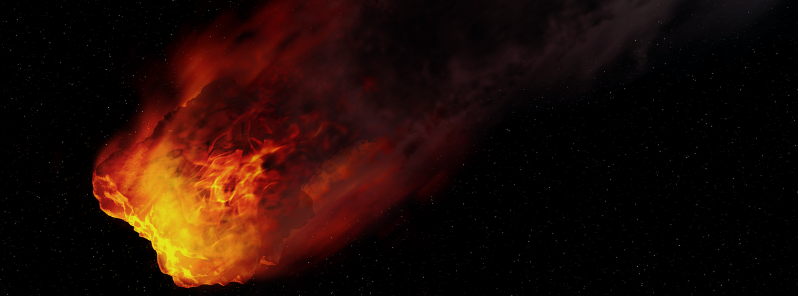New evidence supports giant asteroid impact 12 800 years ago

A research team from South Africa has discovered new evidence that suggests Earth was struck by an asteroid or meteorite 12 800 years ago. The event resulted in global consequences and the extinction of many species at the period of an episode called Younger Dryas. The study was published on October 2, 2019.
The group was led by Professor Francis Thackeray of the Evolutionary Studies Institute at the University of the Witwatersrand in Johannesburg, South Africa. The team discovered evidence of "platinum spike" at an area called Wonderkrater in the Limpopo Province, north of Pretoria.
Thackeray, along with researcher Philip Pieterse from the University of Johannesburg and Professor Louis Scott of the University of the Free State, found the evidence from a core drilled in a peat deposit, remarkably in a sample approximately 12 800 years old.
"Our finding at least partially supports the highly controversial Younger Dryas Impact Hypothesis (YDIH). We seriously need to explore the view that an asteroid impact somewhere on earth may have caused climate change on a global scale, and contributed to some extent to the process of extinction of large animals at the end of the Pleistocene, after the last ice age," Thackeray stated, noting that meteorites are abundant in platinum.
During the Younger Dryas, a lot of mammals became extinct in North America, South America, and Europe. Meanwhile, in South Africa, a few large animal species became extinct near that era. The study showed that the human population may have also been impacted indirectly during that period. In North America, there was a massive termination of Clovis people's stone tool technology. Archaeologists in South Africa have tracked an almost simultaneous termination of the Robberg stone artifact industry related to people in some areas of the country such as the area around Boomplaas near the Cango Caves, southern Cape area, near Oudshoorn town.
"Without necessarily arguing for a single causal factor on a global scale, we cautiously hint at the possibility that these technological changes, in North America and on the African subcontinent at about the same time, might have been associated indirectly with an asteroid impact with major global consequences," said Thackeray. "We cannot be certain, but a cosmic impact could have affected humans as a result of local changes in the environment and the availability of food resources, associated with sudden climate change."
The team gathered evidence from a pollen at Wonderkrater to show that around 12 800 years ago, a temporary cooling occurred, which is linked to the Younger Dryas temperature drop. Some scientists said this cooling in widespread sites could at least have been potentially associated with the worldwide dispersal of atmospheric dust that is rich in platinum. Furthermore, a large crater has also been found in northern Greenland beneath the Hiawatha Glacier.
Image credit: Francis Thackeray
"There is some evidence to support the view that it might possibly have been the very place where a large meteorite struck the planet earth 12 800 years ago," Thackeray explained. "If this was indeed the case, there must have been global consequences."
The research team believes that their discovery at Wonderkrater is just part of the strengthening hypothesis that an asteroid impact might have really happened at that period. Younger Dryas platinum spikes have also been discovered in Greenland, Eurasia, North America, Mexico, and Chile. Wonderkrater is the 30th site in the world for the evidence.
This study is expected to be consolidated with those conducted in other parts of the Earth, acknowledging that the source of the platinum found at Wonderkrater could theoretically be cosmic dust that was spread in the atmosphere after a meteorite made an impact in Greenland.
"Our evidence is entirely consistent with the Younger Dryas Impact Hypothesis," Thackeray remarked.
Thackeray and his team's research is supported by the National Research Foundation and the DST/NRF Centre of Excellence for the Palaeosciences and is published on Palaeontologia Africana.
Reference
"The Younger Dryas interval at Wonderkrater (South Africa) in the context of a platinum anomaly" – Thackeray, J.F. et al. – Palaeontologia Africana – DOI: https://hdl.handle.net/10539/28129
Abstract
Wonderkrater in the Limpopo Province in South Africa is a late Quaternary archaeological site with peat deposits extending back more than 30 000 years before the present. Palaeoclimatic indices based on multivariate analysis of pollen spectra reflect a decline in temperature identifiable with the Younger Dryas (YD). A prominent spike in platinum is documented in aWonderkrater sample (5614) with a mean date of 12 744 cal yr BP using a Bayesian model, preceding the onset of the YD cooling event. The YD platinum spike at Wonderkrater is the first to be observed in Africa in the southern hemisphere, supplementing new discoveries from Patagonia in South America, in addition to more than 25 sites with such platinum anomalies in the northern hemisphere. The observations from South Africa serve to strengthen ongoing assessments of the controversial YD Impact Hypothesis, whereby it is proposed that a meteorite or cometary impact contributed to a decline in temperature, associated inter alia with dispersion of atmospheric dust, mammalian extinctions and cultural changes.
Featured image credit: @AlexAntropov86/Pixabay

This event could explain Noah’s Flood.
With much interest I just read this open access article about the worldwide flooding. The article mentions a comet instead of an asteroid or comets which reshaped earth with a massive amount of water 12.800 years ago
http://maajournal.com/Issues/2019/Vol19-1/7_Jaye%2019(1).pdf
Thank you for this link!